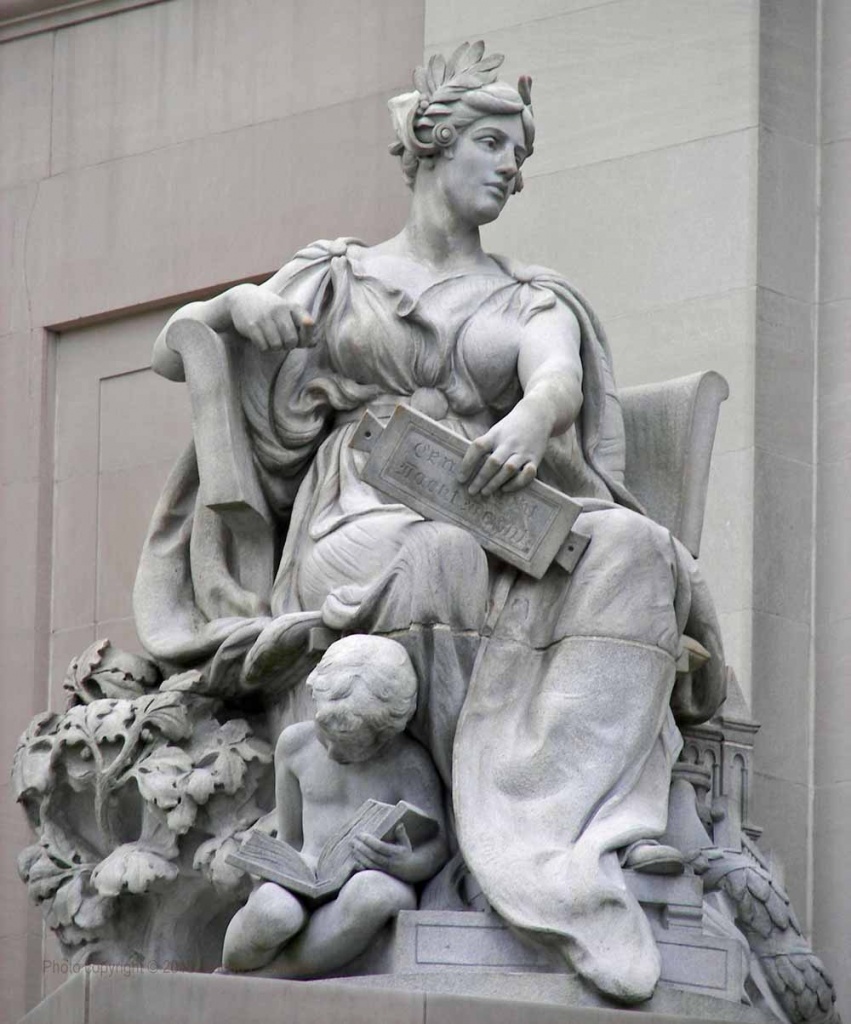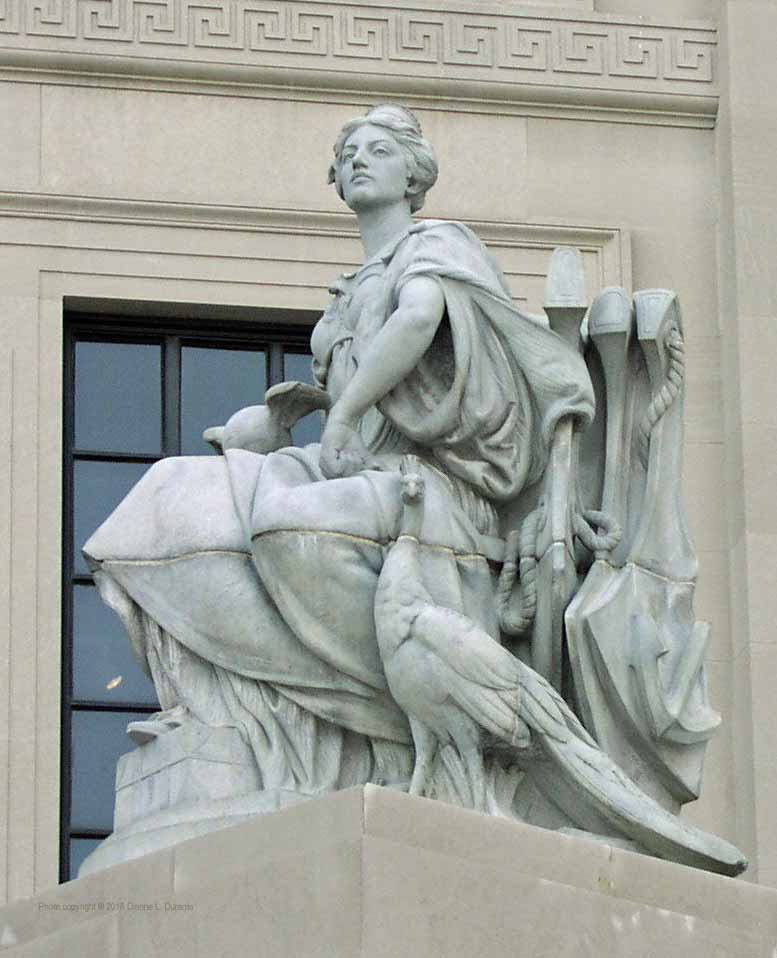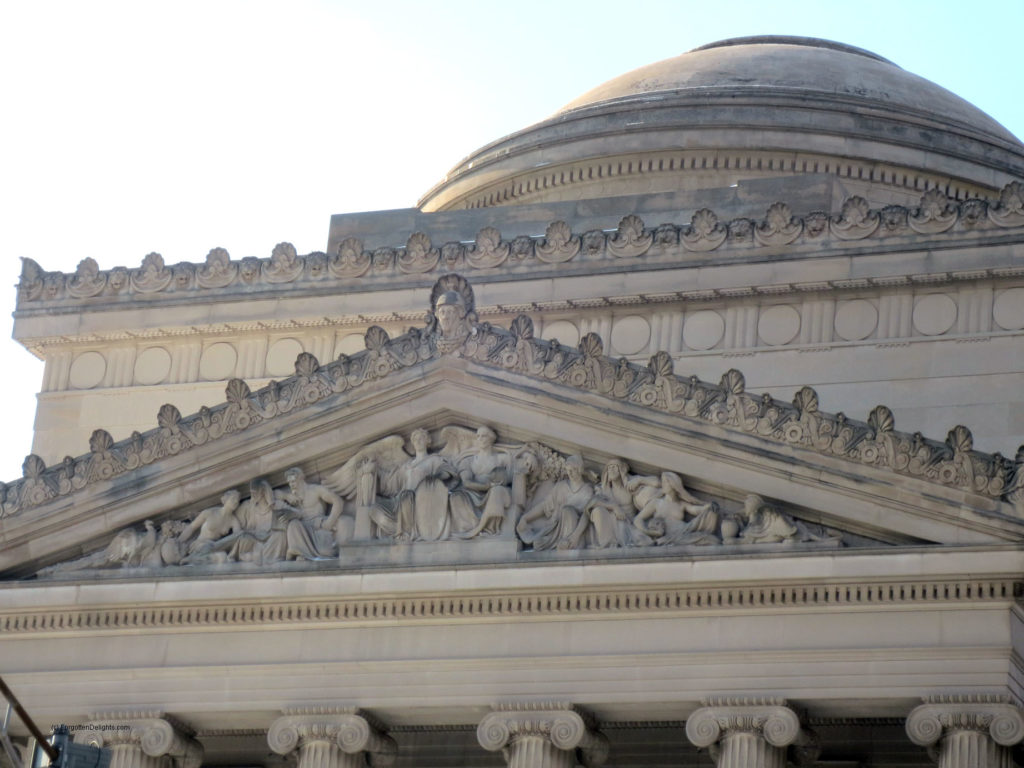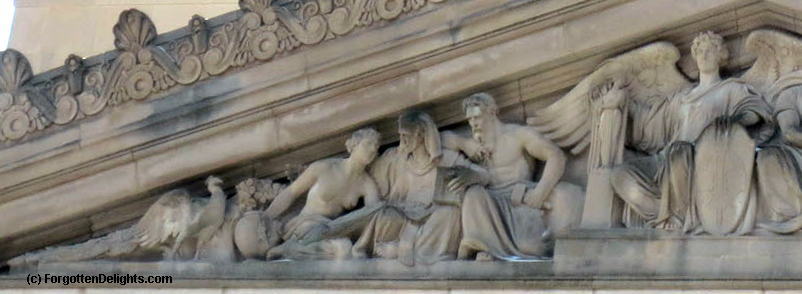- Date: ca. 1900
- Architect: McKim, Meade & White
- Sculptor: Daniel Chester French and others (see below)
- Medium & size: white stone (limestone? marble? no one says)
- Location: Eastern Parkway, Brooklyn.
A note on the photos: Taking photos of sculptures that are high on a facade is a tricky business. If the sculptures are in shade, it’s nearly impossible. The photos below were taken when only the east facade was well lit. Patience: one of these days, I’ll get back and shoot the north and west side in better light. Meanwhile, as far as I can tell, these are the only close-ups available on the web, which makes them (in the most precise mathematical sense) better than nothing.

Guarding the entrance: Manhattan and Brooklyn
According Adeline Adams’ Daniel Chester French, Sculptor (1932), “At a very real sacrifice of time, strength, and personal profit, Mr. French, after much solicitation, consented to assume responsibility and to make contracts for all the sculpture on the façade of the Brooklyn Institute of Arts and Sciences. Its triumphant conclusion was a proof of executive ability imaginatively and harmoniously employed.”
Brooklyn (on the left side of the main entrance) and Manhattan (on the right) are gorgeous allegorical works by Daniel Chester French, who also sculpted the Four Continents at the Customs House, Bowling Green, and the Hunt Memorial. Originally they were at the Brooklyn end of the Manhattan Bridge; they were moved to the Brooklyn Museum after exhaust from automobiles became too destructive. For more on these two sculptures, see this post.

Daniel Chester French, Brooklyn, 1916. Brooklyn Museum of Art. Photo copyright © 2018 Dianne L. Durante 
Daniel Chester French, Manhattan, 1916. Brooklyn Museum of Art. Photo copyright © 2018 Dianne L. Durante
Pediment
These figures are the work of Daniel Chester French and Adolph Weinman (see Rea and other sculptures in Manhattan). The central figures represent Art and Science. On our left, reading from left to right, are a peacock (symbolizing beauty), Painting (with a canvas), Architecture (wearing an Egyptian headdress: credit for the pyramids?), and Sculpture (with a mallet).
On our right are Astronomy (celestial maps?), Geology (not sure of the attribute), and Biology (holding a skull). At the far right is a sphinx, symbolizing knowledge.

Brooklyn Museum: whole pediment. Photo copyright © 2019 Dianne L. Durante 
Brooklyn Museum: left side of pediment. Photo copyright © 2019 Dianne L. Durante
Brooklyn Museum: right side of pediment. Photo copyright © 2019 Dianne L. Durante
Sculptures on the attic storey facade
The figures on the attic story do not correspond to the names inscribed on the level below them. In fact, the figures don’t always represent the figures that are named below. A 1910 publication explaining the sculpture program noted that:
The statues are not portraits … Neither do they bear a direct relation to the names below them. Instead they symbolize those factors that made certain periods in the world’s history notable as stages in the development of civilization.
The 1910 publication was quoted in a letter to the editor of the New York Sun on 6/21/2005, signed by Kevin Stayton as Chief Curator of the Brooklyn Musem.
Sculptures on the east facade
To help you keep these figures straight as you peer up at them, I’m citing the inscriptions that appear below and between them. Remember that the inscriptions don’t necessarily correspond to the figures near them.
[Inscriptions: RAMSES, HAMMURABI, NEBUCHADNEZZAR, ZOROASTER, CYRUS, MANU]
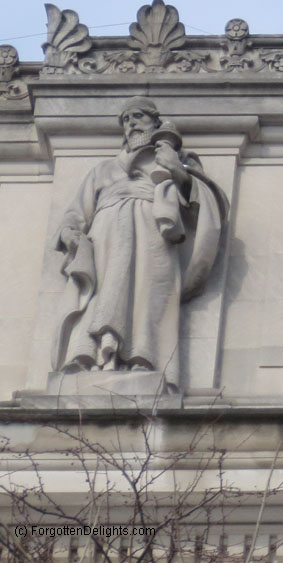
Above: Zoroaster, representing Persian Philosophy, by Edmund T. Quinn (who also did Edwin Booth as Hamlet and Victor Herbert in Central Park.
[Inscription: BUDDHA]
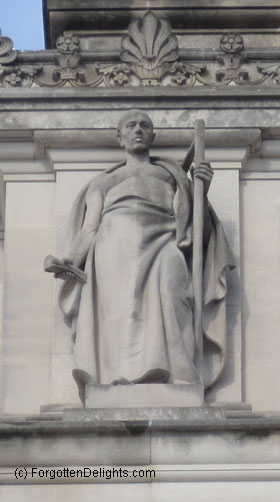
Above: Sankara, representing Indian Philosophy (details here), by Edward Clark Potter, best known for the lions in front of New York Public Library.
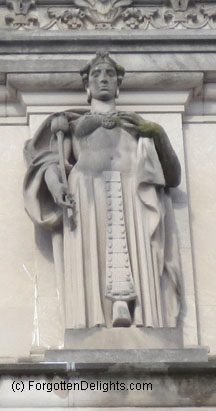
Above: Indian Literature, by Attilio Piccirilli (more here). According to the Bulletin of the Brooklyn Institute of Arts and Sciences (1908-1909):
Mr. Piccirilli has taken as the expression of this ideal [Indian Literature] … a beautifully natural woman whose very form is an expression of the truth; whose dignity of bearing commands profound respect; whose consciousness of the infinite power of the truth, the beauty, the love, the humanity and the divinity of the great Literature created by the poets, prophets, philosophers, saints and martyrs of her people from the dawn of civilization, is an inspiration to all the nations and peoples of the world. This personification of the Literature of the Vedas, the Mahabarata and the Upanishads in the earlier periods and of the Sakuntala of Kalidasa, the Sayings of Buddha, and of all the other creative contributions to the expression in beautiful and permanent form of the wisdom of the Indian people, finds symbolic as well as real expression in this sculpture.
Piccirilli designed the figures on the Maine Monument and the Firemen’s Memorial. He belonged to a notable family of stonecutters who often executed work for Daniel Chester French and others.
[Inscription: KALIDASA]

Above: Manu, representing Indian Law (more here), also by Attilio Piccirilli (on whom see above)

Above: Buddha (holding the dharma wheel), representing Indian Religion, by Edward Clark Potter. See Sankara above.
Sculptures on the north facade, east (left) of the pediment
To help you keep these figures straight as you peer up at them, I’m citing the inscriptions that appear below and between them. Remember that the inscriptions don’t necessarily correspond to the figures near them.
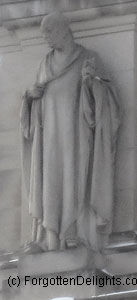
Above: Confucius, representing Chinese Philosophy, by Karl Bitter, who’s responsible for Franz Sigel on Riverside Drive, Henry Hudson in the Bronx, and the Pulitzer Fountain near the Plaza Hotel.
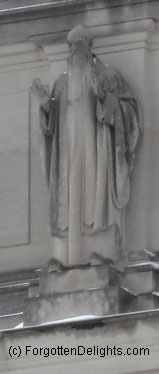
Above: Lao-Tse, representing Chinese Religion, also by Karl Bitter (see Confucius)
[Inscription: CONFUCIUS]

Above: Chinese Art, by Karl Bitter (see Confucius)
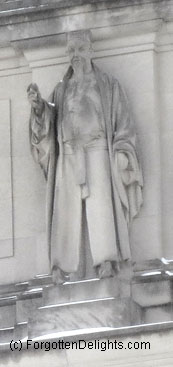
Above: Chinese Law, also by Karl Bitter (see Confucius)
[Inscription: LAO-TSE]
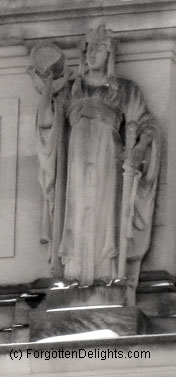
Above: Japanese Art, by Janet Scudder, who’s best known for charming garden sculptures.
[Inscription: MOSES]
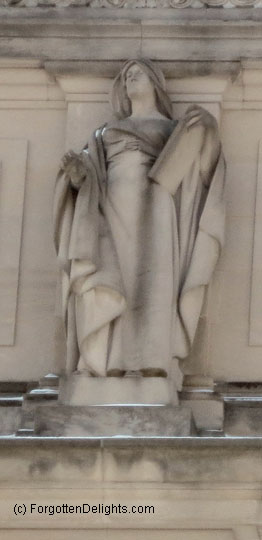
Above: Hebrew Law (an allegorical figure holding the Ten Commandments, related to Moses), by Augustus Lukeman, who sculpted the Straus Memorial and a haunting World War I memorial near the Wollman Rink in Prospect Park.
[Inscription: DAVID]
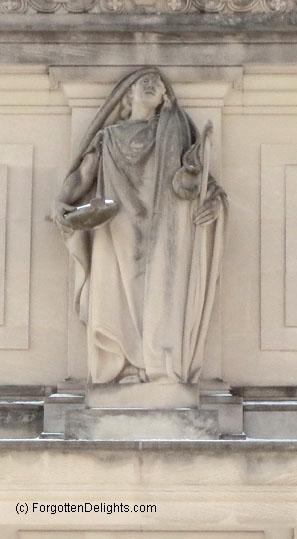
Above: Hebrew Psalmist (obviously not David, but related allegorically), also by Lukeman (see Hebrew Law)
[Inscription: JEREMIAH]

Above: Isaiah, representing Hebrew Prophecy, also by Lukeman (see Hebrew Law)
[Inscription: ISAIAH]

Above: St. Paul, representing a Hebrew Apostle, also by Lukeman (see Hebrew Law)
[Inscription: ST. PETER]

Above: the Genius of Islam (related to Mohammed, but even ca. 1900 Mohammed was rarely represented in Western art), by Charles Keck, who created Father Duffy near Times Square.
[Inscription: ST. PAUL]
Sculptures on the north facade, west (right) of the pediment
To help you keep these figures straight as you peer up at them, I’m citing the inscriptions that appear below and between them. Remember that the inscriptions don’t necessarily correspond to the figures near them.
[Inscription: PINDAR]

Above: Homer, representing Greek Epic Poetry, by Daniel Chester French; see Manhattan and Brooklyn near the beginning of this page. This is based on a famous ancient sculpture of Homer.
[Inscription: AESCHYLUS]
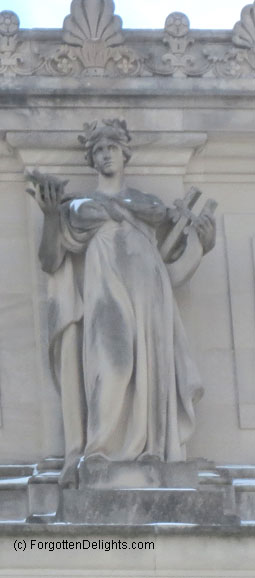
Above: Greek Lyric Poetry, an allegorical figure related to Pindar, by Daniel Chester French. See his Manhattan and Brooklyn near the beginning of this page.
[Inscription: SOPHOCLES]
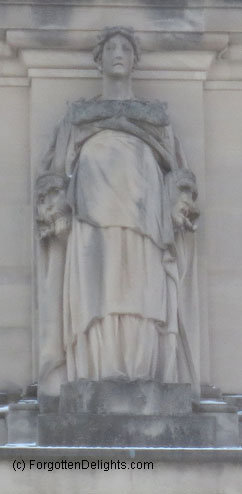
Above: Greek Drama, holding the masks of comedy and tragedy, related to Aeschylus, by George T. Brewster. The only work in my notes by Brewster is the Pleasant Plains Memorial on Staten Island.
[Inscription: PERICLES]
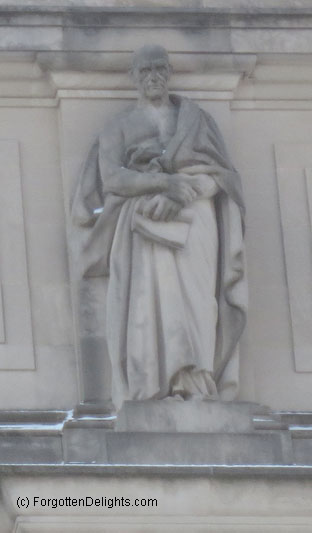
Above: Pericles (probably preparing to deliver his famous Funeral Oration), representing the Greek State; by George T. Brewster. See Greek Drama above.
[Inscription: HERODOTUS]
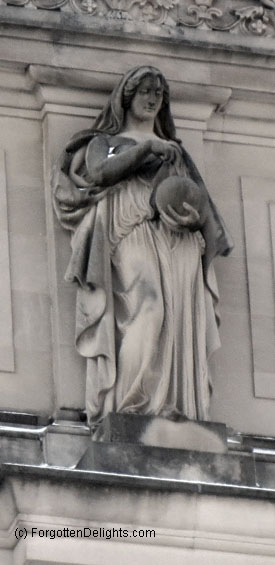
Above: Greek Science (holding a bottle of water), related to Archimedes. Could the artist possibly be refering to Archimedes’ discovery of the displacement of water when he lowered himself into his bath? By Kenyon Cox, who is known for painting as well as sculpture.
[Inscription: THUCYDIDES]
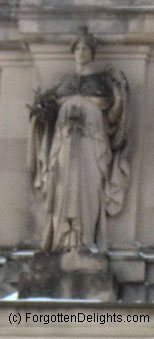
Above: Minerva (i.e. Athena, with the usual aegis and helmet), representing Greek Religion, by Daniel Chester French. See Manhattan and Brooklyn near the beginning of this page.
[Inscription: SOCRATES]

Above: Plato (looking serious and philosophical), representing Greek Philosophy, by Herbert Adams, whose William Cullen Bryant stands in Bryant Park.
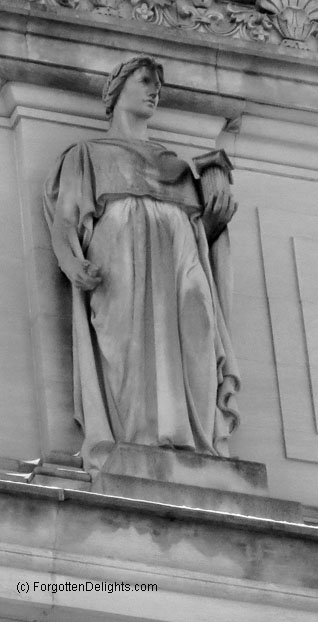
Above: Greek Architecture (holding the top of an Ionic column), related to Phidias, architect of the Parthenon; by Herbert Adams. See Plato.
[Inscription: DEMOSTHENES]
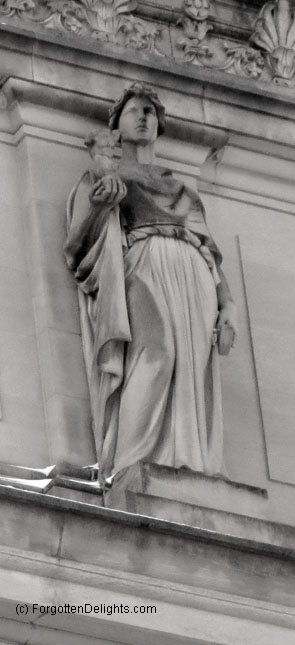
Above: Greek Sculpture (with a sculpted torso and a mallet), related to Praxiteles, one of the most famous Greek sculptors (4th century B.C.); by Herbert Adams. See Plato.
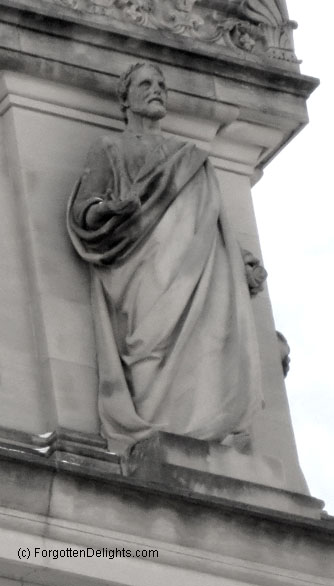
Above: Demosthenes, representing Greek Letters, by Herbert Adams. See Plato above.
Sculptures on the west facade
To help you keep these figures straight as you peer up at them, I’m citing the inscriptions that appear below and between them. Remember that the inscriptions don’t necessarily correspond to the figures near them.

Above: Justinian (holding a huge book), representing Roman Law, by Johannes Gelert, who created the figure of Denmark on the Customs House cornice, and nothing else in New York that I know of.
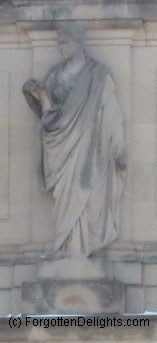
Above: Julius Caesar, representing Roman Statesmen, by Johannes Gelert. See Justinian.
[Inscription: CICERO]

Above: Augustus Caesar (wearing his Augustus of Primaporta outfit), representing the Roman Empire, by Johannes Gelert; see Justinian.
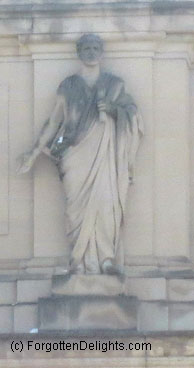
Above: Cicero (as an orator, gesturing and with a scroll), representing Roman Orators, by Johannes Gelert. See Justinian.
[Inscription: VIRGIL]
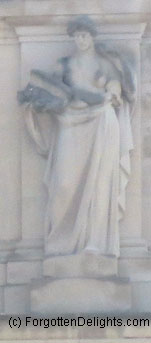
Above: Virgil (holding a book?), representing Latin Epic Poetry, by Carl Heber, who sculpted the Spirit of Commerce and Spirit of Industry at the east end of the Manhattan Bridge, and the Greenpoint War Memorial in Monsignor McGolrick Park.
If you’re exasperated with the quality of these photos, go back and read the apology / explanation that follows the name, date, and location at the beginning of the article.
More
- In Getting More Enjoyment from Sculpture You Love, I demonstrate a method for looking at sculptures in detail, in depth, and on your own. Learn to enjoy your favorite sculptures more, and find new favorites. Available on Amazon in print and Kindle formats. More here.
- Want wonderful art delivered weekly to your inbox? Check out my free Sunday Recommendations list and rewards for recurring support: details here.
